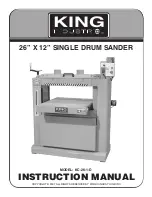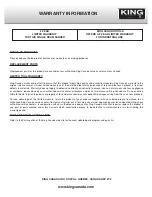
GENERAL & SPECIFIC
SAFETY RULES
1. KNOW YOUR TOOL
Read and understand the owners manual and labels affixed to the
tool. Learn its application and limitations as well as its specific
potential hazards.
2. GROUND THE TOOL.
This tool is equipped with an approved 3-conductor cord and a
3-prong grounding type plug to fit the proper grounding type
receptacle. The green conductor in the cord is the grounding wire.
NEVER
connect the green wire to a live terminal.
3. KEEP GUARDS IN PLACE.
Keep in good working order, properly adjusted and aligned.
4. REMOVE ADJUSTING KEYS AND WRENCHES.
Form habit of checking to see that keys and adjusting wrenches
are removed from tool before turning it on.
5. KEEP WORK AREA CLEAN.
Cluttered areas and benches invite accidents. Make sure the floor
is clean and not slippery due to wax and sawdust build-up.
6. AVOID DANGEROUS ENVIRONMENT.
Don’t use power tools in damp or wet locations or expose them to
rain. Keep work area well lit and provide adequate surrounding
work space.
7. KEEP CHILDREN AWAY.
All visitors should be kept at a safe distance from work area.
8. MAKE WORKSHOP CHILD-PROOF.
With padlocks, master switches or by removing starter keys.
9. USE PROPER SPEED.
A tool will do a better and safer job when operated at the proper
speed.
10. USE RIGHT TOOL.
Don’t force the tool or an attachment to do a job for which it was
not designed.
11. WEAR PROPER APPAREL.
Do not wear loose clothing, gloves, neckties or jewelry (rings,
watch) because they could get caught in moving parts. Non-slip
footwear is recommended. Wear protective hair covering to
contain long hair. Roll up long sleeves above the elbows.
12. ALWAYS WEAR SAFETY GLASSES.
Always wear safety glasses (ANSI Z87.1). Everyday eyeglasses
only have impact resistant lenses, thet are
NOT
safety glasses.
Also use a face or dust mask if cutting operation is dusty.
13. DON’T OVERREACH.
Keep proper footing and balance at all times.
14. MAINTAIN TOOL WITH CARE.
Keep tools sharp and clean for best and safest performance.
Follow instructions for lubricating and changing accessories.
15. DISCONNECT TOOLS.
Before servicing, when changing accessories or attachments.
16. AVOID ACCIDENTAL STARTING.
Make sure the swich is in the ‘’OFF’’ position before plugging in.
17. USE RECOMMENDED ACCESSORIES.
Consult manual for recommended accessories. Follow the
instructions that accompany the accessories. The use of improper
accessories may cause hazards.
18. NEVER STAND ON TOOL.
Serious injury could occur if the tool tips over. Do not store
materials such that it is necessary to stand on the tool to reach
them.
19. CHECK DAMAGED PARTS.
Before further use of the tool, a guard or other parts that are
damaged should be carefully checked to ensure that they will
operate properly and perform their intended function. Check for
alignment of moving parts, breakage of parts, mounting, and any
other conditions that may affect its operation. A guard or other
parts that are damaged should be properly repaired or replaced.
20. NEVER LEAVE MACHINE RUNNING UNATTENDED.
Turn power ‘’OFF’’. Don’t leave any tool running until it comes to a
complete stop.
SPECIFIC SAFELY RULES FOR DRUM SANDERS
1
.
DO NOT
jam workpiece into the machine during operation. Firmly
grasp the workpiece in both hands and ease it into the machine
using light pressure.
2. DO NOT
allow anyone to stand at the outfeed end when feeding
your stock.
3. DO NOT
attempt to sand thin stock by using a “dummy” board under
your workpiece.
4. DO NOT
place hands near, or in contact with, sanding drum during
operation.
5. DO NOT
allow fingers to get pinched between board and conveyor
belt during operation. This may pull the operator’s hand into the
machine and cause serious injury or death!
6. NEVER
operate the sander without an adequate dust collection
system in place and running.
7. NEVER
sand more than one piece of stock at a time.
8. ALWAYS
inspect workpiece for nails, staples, knots, and other
imperfections that could be dislodged and thrown from the machine
during sanding operations.



























